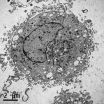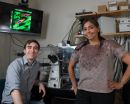(Press-News.org) LA JOLLA, CA--December 17, 2014--Chemists at The Scripps Research Institute (TSRI) have invented a powerful method for joining complex organic molecules that is extraordinarily robust and can be used to make pharmaceuticals, fabrics, dyes, plastics and other materials previously inaccessible to chemists.
"We are rewriting the rules for how one thinks about the reactivity of basic organic building blocks, and in doing so we're allowing chemists to venture where none has gone before," said Phil S. Baran, the Darlene Shiley Chair in Chemistry at TSRI, whose laboratory reports the finding on functionalized olefin cross-coupling this week in Nature.
With the new technique, scientists can join two compounds known as olefins to create a new bond between their carbon-atom backbones. Carbon-to-carbon coupling methods are central to chemistry, but until now have been plagued by certain limitations: they often fail if either of the starting compounds contains small, reactive regions known as "functional groups" attached to their main structure. They also frequently don't work well in the presence of "heteroatoms"--non-carbon atoms such as nitrogen, oxygen and iodine--despite the importance of these types of atoms in chemical synthesis.
The new method is what chemists call "mild," meaning that it doesn't require the use of extreme temperatures or pressures, nor harsh chemicals. As a result, portions of the building blocks used that are particularly fragile remain unaltered by the reaction.
"Functional groups that would be destroyed by other cross-coupling methods are totally unscathed when using our method," said Julian C. Lo, a graduate student who was a co-lead author of the report with Research Associate Jinghan Gui.
Natural Products as Launching Pad
The innovation arose from a Baran laboratory project to synthesize natural compounds found in traditional Chinese medicines. As they developed a technique for constructing the desired molecules in the lab, the researchers recognized that they could adapt the technique to join two relatively simple olefins together, as they reported in January 2014 in the Journal of the American Chemical Society.
The next step was to adapt the technique in order to combine more complex olefins attached to heteroatoms, which is reported in the new Nature paper.
"The reaction setup is easy," said Gui. "We use a simple iron catalyst, a commercially available silane and ethanol [i.e., grain alcohol] as the solvent; and we can do the reaction in an open flask, meaning that we don't need to exclude air or moisture."
Lo, Gui and their colleagues demonstrated the robustness of their reaction by taking an unconventional approach and running it in vodka, gin, whiskey, tequila, beer and wine instead of pure alcohol. "Think of wine--it has this incredibly complex flavor because of the hundreds of compounds in it besides alcohol. And yet our reaction is still able to proceed in that mess, whereas traditional coupling techniques can't even handle water that well," said Lo.
Immediate Applications, New Vistas
Importantly, the chemists showed that their reaction can be used to make compounds that were previously either unpractical to synthesize or couldn't have been made at all. In their report they described making more than 60 compounds with the new method. "Around 90% of these are new chemical entities," said Baran. "We expect that this method will have immediate application to pharmaceuticals, materials, and even agricultural and fragrance chemistry."
Indeed Baran already has used the method to help one company solve a difficult chemical synthesis problem and has disseminated the method's details to other researchers at scientific meetings. Beyond the immediate practical applications, the new method removes some significant constraints on chemists' thinking, essentially opening up new worlds of possibilities.
"This new chemistry allows for bond constructions that have previous been simply unimaginable," said Baran.
INFORMATION:
Other authors of the paper, "Functionalized Olefin Cross-Coupling to Construct Carbon-Carbon Bonds," were Yuki Yabe and Chung-Mao Pan of TSRI. For more information, see http://www.nature.com
Funding for the research was provided in part by the U.S. National Institute of General Medical Sciences, part of the National Institutes of Health (GM-097444).
Johns Hopkins and University of Alberta researchers have identified a single protein as the root of painful and dangerous allergic reactions to a range of medications and other substances. If a new drug can be found that targets the problematic protein, they say, it could help smooth treatment for patients with conditions ranging from prostate cancer to diabetes to HIV. Their results appear in the journal Nature on Dec. 17.
Previous studies traced reactions such as pain, itching and rashes at the injection sites of many drugs to part of the immune system known as mast ...
Researchers found 53 existing drugs that may keep the Ebola virus from entering human cells, a key step in the process of infection, according to a study led by researchers at the Icahn School of Medicine at Mount Sinai and the National Institutes of Health (NIH), and published today in the Nature Press journal Emerging Microbes and Infections.
Among the better known drug types shown to hinder infection by an Ebola virus model: several cancer drugs, antihistamines and antibiotics. Among the most effective at keeping the virus out of human cells were microtubule inhibitors ...
Researchers from Intermountain Medical Center in Salt Lake City have identified a new "sliding scale" model used to rule out potentially deadly blood clots in the lungs, known as pulmonary embolisms, that is more accurate than current diagnostic methods.
The new model, which factors in a patient's age, more accurately identifies a patient's risk of the often-deadly blood clots and can more easily rule out the need for additional, more invasive tests, helping to reduce unnecessary costs.
The research is published in the medical journal, CHEST.
Pulmonary embolism is ...
The engineered spring flood that brought water to previously dry reaches of the lower Colorado River and its delta resulted in greener vegetation, the germination of new vegetation along the river and a temporary rise in the water table, according to new results from the binational team of scientists studying the water's effects.
The experimental pulse flow of water was the result of a U.S.-Mexico agreement called Minute 319.
"The pulse flow worked," said Karl W. Flessa, co-chief scientist for the Minute 319 Science Team. "A small amount of water can have a big effect ...
New research helps explain a paradoxical effect of certain antidepressants--that they may actually worsen symptoms before helping patients feel better. The findings, highlighted in a paper publishing online December 17 in the Cell Press journal Trends in Cognitive Sciences, may help investigators fix the problem as well as create new classes of drugs to treat depression.
Selective serotonin reuptake inhibitors (SSRIs) are the most widely prescribed class of antidepressant drugs, and they work by increasing levels of a brain chemical called serotonin. While this boost ...
In an article to be published in the January issue of BioScience, two philosophers tackle one of the most divisive arguments in modern biology: the value of the theory of "kin selection."
Kin selection is the idea that because genes influence behavior, and because an animal that helps its relatives helps to spread genes likely identical to its own, animals will evolve to favor kin. Researchers have spent decades testing this explanation for apparent animal altruism, but in recent years, critics, notably Martin Nowak of Harvard University and the famous naturalist and ...
(PHILADELPHIA) - Researchers look to understand the causes of amyotrophic lateral sclerosis (ALS), in the hope of finding new ways to treat the disease. A new study published online today (December 17th) in the Cell Press journal Neuron shows that a common gene mutation in ALS generates a deadly protein that may cause the damage in the brain that leads to ALS.
About 5 percent of ALS patients carry an altered version of a gene called C9orf72, which in ALS patients contains hundreds of repeat sequences that otherwise are not present in normal individuals. Since the gene's ...
When faced with making choices, but lack sufficient evidence to guarantee success, our brain uses elapsed time as a proxy for task difficulty to calculate how confident we should be, a team of neuroscientists has found. Their findings, which appear in the journal Neuron, help untangle the different factors that contribute to the decision-making process.
"In our daily lives, we make many decisions," says Roozbeh Kiani, an assistant professor in NYU's Center for Neural Science and one of the study's authors. "Sometimes the evidence afforded us is strong, enabling us to ...
More than 90 percent of cancer-related deaths are caused by the spread of cancer cells from their primary tumor site to other areas of the body. A new study has identified how one important gene helps cancer cells break free from the primary tumor.
A gene normally involved in the regulation of embryonic development can trigger the transition of cells into more mobile types that can spread without regard for the normal biological controls that restrict metastasis, the new study shows.
Analysis of downstream signaling pathways of this gene, called SNAIL, could be used ...
PITTSBURGH--A stream runs through it. A much nicer, healthier stream.
Pittsburgh's Frick Park is home to Nine Mile Run, a stream that had been known as "Stink Creek." From 2003 to 2006, the City of Pittsburgh and the U.S. Army Corps of Engineers poured $7.7 million into restoring 2.2 miles of the stream and tributaries into waterways approximating what they were prior to urban development.
The project remains one of the largest urban-stream restorations undertaken in the United States.
What can this restoration teach us as we continue to deal with streams affected ...



